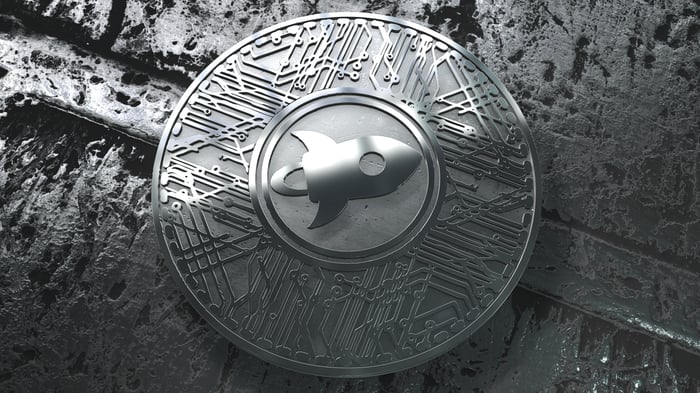For more than 100 years, the stock market has served as a wealth-creating machine. While it may not outperform commodities or bonds every single year, its average annual return over the long run substantially outpaces all other asset classes.
Then cryptocurrencies came along and completely turned this entrenched ideology on its head. Whereas the benchmark S&P 500 has gained 273% over the trailing 10-year period, we’ve watched Bitcoin approach a nearly 8,000,000,000% gain in a little over 11 years. That’s 8 billion percent!

The Shiba Inu dog breed has inspired a handful of popular cryptocurrencies. Image source: Getty Images.
Shiba Inu’s mammoth gains could quickly evaporate
Although Bitcoin continues to generate buzz, especially with the first Bitcoin futures-based exchange-traded fund making its debut this week, it’s Shiba Inu (CRYPTO:SHIB) that’s been turning heads with its gains. Since making its debut on Aug. 1, 2020, Shiba Inu has gained more than 5,500,000%, as of late evening Oct. 20.
Why Shiba Inu? To begin with, a number of popular cryptocurrency exchanges have listed SHIB for trading, which has lifted ownership and made investors more aware of its existence.
There’s also the clear tie-in to Tesla CEO Elon Musk, who recently adopted a Shiba Inu dog named Floki. Anytime Musk tweets about his dog or posts a meme featuring a Shiba Inu-breed dog, Shiba Inu tokens head skyward.
The July 2021 launch of ShibaSwap, a decentralized exchange that allows investors to stake their coins to earn interest, is another reason for the recent bullishness.
But we’ve witnessed plenty of flash-in-the-pan cryptocurrencies in recent years, and Shiba Inu might be the next in line. It offers virtually no utility outside of a cryptocurrency exchange — online business directory Cryptwerk shows only 91 merchants accept SHIB for payment — and according to Coinbase, has an average holding time of less than two weeks. In other words, this suggests investors don’t really care about SHIB’s future and are more or less hoping that the near-term hype continues.
This raises another problem — the likelihood of a correction. Historically, equities that generate massive short-term gains rarely are able to hold onto those gains without a significant correction to the downside. This bodes poorly for Shiba Inu.

Image source: Getty Images.
These cryptocurrencies can run circles around Shiba Inu by 2026
Admittedly, I’m a crypto skeptic. While I foresee blockchain technology playing a role in payments and other nonfinancial applications, I also recognize that investors have a long history overestimating the adoption of new technology.
I’m also leery of the constant technological dilution cryptocurrencies face. Without any barrier to entry, new blockchain projects are emerging on a regular basis. This leaves most tokens and tethered blockchains without any moat or competitive advantage (ahem, Shiba Inu).
Nevertheless, there are three cryptocurrencies that I believe can handily outperform SHIB over the coming five years.
Ethereum
Ethereum (CRYPTO:ETH) is what I’d consider to be the most-established and intriguing digital currency. Bitcoin may have a few years on the second-largest crypto by market cap, but Ethereum offers real-world payment and nonfinancial application potential.
A couple of factors make Ethereum special. First and foremost is the network’s use of smart contracts. A smart contract uses protocols that verify, enforce, and facilitate a contractual agreement between two parties. Smart contracts offer the ability to streamline supply-chain management without massive paper trails and can be used in financial applications to create transparent and legally binding agreements.
Second, Ethereum is creating a lot of hype regarding its role in decentralized finance (DeFi). DeFi utilizes smart contracts on financially focused blockchain to complete transactions. The key here is that these transactions bypass financial institutions that might otherwise slow or halt these payments.
And third, Ethereum has tangible support. The Enterprise Ethereum Alliance (EEA) now has more than 100 members, and each one is playing a role in promoting the use of Ethereum’s blockchain in real-world applications. While financial applications are the most logical use of blockchain technology, quite a few EEA members would benefit from the logistics aspect of Ethereum’s smart contracts.

Image source: Getty Images.
Stellar
Since Shiba Inu is strictly a payments-focused digital currency, an apples-to-apples crypto that can crush it over the next five years is Stellar (CRYPTO:XLM). Stellar is currently the 22nd-largest cryptocurrency by market cap ($9.4 billion), compared to Shiba Inu at No. 19 ($11.3 billion).
At the heart of financially focused blockchain technology is the idea of making payments faster, cheaper, and more accessible to everyone. Based on the infrastructure in place today, it can take up to a week for cross-border payments to be validated and settled.
With blockchain, this process is cut down considerably. Stellar can turn a fiat currency into its Lumen coin (XLM), complete a transfer of XLM from Point A to B on its network, and exchange XLM back into native fiat currency, all within a few seconds. Stellar boasts one of the fastest validation and settlement times for payments among major digital-currency projects.
Furthermore, Stellar’s transaction costs are exceptionally cheap (about $0.000004 per transaction). To put this into context, it would take about 250,000 transactions for a user to rack up the equivalent of $1 in fees.
But the key to outperforming SHIB is the fact that Stellar has real-world applications. For instance, while partnered with IBM, Stellar’s blockchain network was tested by a dozen major banks in the South Pacific region four years ago.
Stellar may not have Elon Musk’s tweets in its sails, but unlike Shiba Inu, it has tangible reasons to increase in value.

Image source: Getty Images.
Cardano
A third well-known cryptocurrency that can run circles around Shiba Inu over the next five years is Cardano (CRYPTO:ADA). Cardano’s ADA token has had an incredible run (it’s up nearly 2,000% over the trailing year), and the transparency of this project and frequency of updates or upgrades provides tangible evidence that things are moving in the right direction.
Cardano’s proof-of-stake blockchain network has outlined five stages of evolution. Last summer, the second major milestone was hit. The Shelley upgrade increased the number of nodes network participants could run, which dramatically increased transaction capacity and set the stage to eventually focus on network scalability. For some context, Cardano only averaged around 2,000 transactions daily on its blockchain prior to Shelley. But in its wake, the number of transactions have shot to north of 100,000 per day.
Last month, the long-awaited third step in the company’s roadmap, known as Goguen, made its debut. Goguen incorporates smart contracts, which ultimately opens the door for financial and nonfinancial decentralized applications that could make Cardano a direct rival to Ethereum.
The next step for Cardano’s development team is scaling the network. This’ll be done by introducing “sidechains.” Theses sidechains are effectively branches of the main network that’ll reduce some of the load and allow for increased capacity.
Despite development delays, Cardano’s network is progressing nicely and should leave Shiba Inu in its dust over the coming years.
This article represents the opinion of the writer, who may disagree with the “official” recommendation position of a Motley Fool premium advisory service. We’re motley! Questioning an investing thesis — even one of our own — helps us all think critically about investing and make decisions that help us become smarter, happier, and richer.






